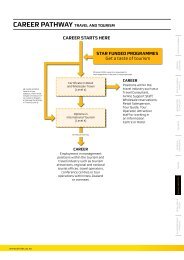Suicide - Wintec
Suicide - Wintec
Suicide - Wintec
- No tags were found...
You also want an ePaper? Increase the reach of your titles
YUMPU automatically turns print PDFs into web optimized ePapers that Google loves.
Understanding Adolescents• Hatim Omar, MD• Professor, Pediatrics, Obstetrics/Gynecology• Chief, Division of Adolescent Medicine• KY CLINIC, Rm. J422, University of Kentucky• Lexington, KY 40536-0284• Tel. 859-323-5643, Fax. 859-323-3795 or 859-257-7706• Email: haomar2@uky.edu
HOMER (1194 BC-800 BC)• Youth is quick in temper, but weak injudgment (Iliad, 800 BC)• It is shameful for the young to questiontheir elders (Odyssey, 800 BC)• I shall go out with the chariots to counseland command for that is the privilege ofthe old; the young must fight in the ranks(Iliad, 800 BC)
Views on AdolescentsHesiod (Greek poet, 8 th Century BC):“I see no hope for the future of ourpeople if we are dependent on thefrivolous youth of today--for certainlyall youth are reckless beyondwords….When I was a boy, we wereexceedingly wise….”
sex is everywhere.‖Scholar’s Opinion onAdolescents• Plato (427-347 BC) (The Republic):―The son feels equal to his father.He has no respect for his parents anymore.All he wants is to be free. Students insulttheir teachers. And, on top of this situation,in the name of liberty and equality,
Scholars Opinion on Adolescents• Confucius (551-479 BC)“A youth who does not respect his elderswill achieve nothing when he grows up,and he will even try to shirk death whenhe reaches old age.”
Western Scholars Opinion onAdolescents•Shakespeare (A Winter‘s Tale) (1600 AD)“I wish that there were no age between ten and threeand twenty or that youth would simply sleep out therest; for there is nothing in between but gettingwenches with child, wronging the ancestry, stealingand fighting.”
YouthMark TwainSamuel Langhorne Clemens(1835-1910)"When I was a boy of 14, my father was soignorant I could hardly stand to have theold man around. But when I got to be 21, Iwas astonished at how much the old manhad learned in seven years"
YouthAsk the young. They knoweverything.Joseph Joubert (1754-1824) French moralist
PUBERTY VS ADOLESCENCE• Humans have the longest puberty andadolescence of all primates• Mean length of puberty is 4 years inWestern cultures• Length of adolescence is variable and maylast a lifetime
PUBERTY VS ADOLESCENCE• Both puberty and adolescence are periodsof rapid change and therefore easilyinfluenced by environmental factors bothpositive and negative
SOME FACTORSVulnerability (risk)PersonnalPhysical abuseSensation seekingEarly pubertyChronic stressDepressionProtectionPersonnalHigh self esteemInternal locus of controlReligiositySocial skillsFamilyLives with one parentBad relations with parentsPoor educational climateSubstance use by parentsLow SESSocialSchool absenteeismBad gradesPoor social networkFamilyGood relations with parentsParents’ support & expectationParents’ monitoringHigh SESSocialLink between school & parentsGood gradesGood school climate
Adolescent Development• All behaviors in adolescents serve apurpose• Behaviors are situational expressions ofmaturational events• As observers, we objectify the behaviors –―risk-taking‖, ―health-compromising‖,―protective‖, ―health-enhancing‖, etc.
Adolescent Developmentand Risk Behaviors• What adults see as ‗problems‘,adolescents often experience as‗solutions‘• and adolescents (and adults, forthat matter) do not give up their‗solutions‘ that easy.
• Adolescence is aperiod of profoundbrain maturation.• It was though thatbrain developmentwas complete byadolescence• It is now knownmaturation is notcomplete until aboutage 24!!!
Risk BehaviorsPsychological Sequelae• Social insecurity• Relationship problems• Untrusting• Exclusion/marginalization• Antisocial/amoralnorms• Violence/poor angerexpression• Poor learning/skillbuilding• Feeling disempowered• Impulsive behaviors• Poor self regard
Electronic Use nearly all young adults (86%), the majorityof teens (71%), and 25% of children ages 8to 12 years have a Facebook account teenagers send and receive 3,705 textmessages per month the majority of teens prefer to contact theirfriends via text messaging (54%) comparedto talking to them on the telephone or seeingthem in person (33 %)
CyberbullyingAny deliberate behavior performed throughelectronic or digital media by individuals orgroups that repeatedly communicateshostile or aggressive messages intended toinflict harm or discomfort on others(Tokunaga, 2010).
Stats on Cyberbullying approximately 20-40% of youths report beingvictimized by a cyberbully males and females are equally representedamong victims the greatest frequency of victimization occurs inthe seventh and eighth grades
Percent Victimized x Grade(Trolly, Hanel, & Shields, n.d.) and from isafe.org (survey from 2004)
Differences Between Cyberbullying andTraditional Bullying cyberbullying ispervasive and canreach a wide audience victims may not knowtheir bully or why theyare being targeted there is no clearindividual or groupswho serve to regulatecyberbullying may be less opportunityfor bystanderintervention cyberbullying is anopportunistic offense cyberbullies cannot seetheir victims’ emotionalreactions
Effects of Cyberbullying academic problems, perception that school isunsafe skipping school, weapon carrying, anddetentions and expulsions are morefrequently reported by youth harassed online depression, social anxiety, low self-esteem headaches, recurrent abdominal pain, sleepdifficulties warning signs include sadness or angerduring or after Internet use, withdrawal fromfriends and activities, school avoidance,declining grades, depression, anxiety
Survival Manual for Parents• Teens do not come with instructionmanuals• Few parents have formal training inparenting• Parents and Teens often need help withconflicts• Need help with Negative TEEN Behavior• Rule #1: Appreciate Complexity ofAdolescence
Adolescence and Sleep• See reduced total night sleep from birth toteen• There is a shift to later bedtime or sleep onsethour in teens.• See 40% reduction in the REM sleep stagefrom ages 10 to 20 years• Healthy Teens need approximately 9 hours ofnocturnal sleep
Consequences of ExcessiveDaytime Sleepiness• Depression• Irritability• Academic Failure• Impulsivity• ADHD-like features• Death from MVAs
Mental Health• General– One fifth to one-third of disability inadolescents (10-18 years)– Major depression increases with age• 9 of very 1000 preschool children• 20/1000 of school-aged• Nearly 50/1000 adolescents and adults
Potential Consequences ofDepression• <strong>Suicide</strong>• Failing grades/reduced academic success• Substance abuse disorders• Abuse• Sexual dysfunction
Potential Consequences ofDepression (Continued)• Sexual promiscuity with unwantedpregnancy/STDs• Social Isolation• Intimate relationship disruption• School Drop• Substance Abuse• Violence
INHALENTS (HUFFING)• Any chemical around the house• Used mostly by younger preteens/teens(as early as 7)• Mixing more than one• Can cause severe brain, lung and liverdamage• Can cause coma or deathanytime, including the first use
INHALENTS (HUFFING)
National Youth Risk Behavior Survey, 2011Percentage of High School Students Who Ever UsedInhalants, by Sex † and Race/Ethnicity, 2011* Sniffed glue, breathed the contents of aerosol spray cans, or inhaled any paints or sprays to get high one ormore times during their life.†F > M§H > W, B
Also known as:PASSOUTSPACEMONKEY
What is the choking game?• self-strangulation or strangulation byanother person with the hands or a nooseto achieve a brief euphoric state causedby cerebral hypoxia.• An activity in which persons strangulatethemselves to achieve euphoria throughbrief hypoxia (It’s suffocation on purpose)• It is differentiated from autoeroticasphyxiation
Who plays the choking game?• Generally boys and girls between 9 and16 years of age.• usually high-achievers in athletics oracademics
CraigMorse16BlakeEdwardConant15TylerGriffin12RandallStamper12KyleO‘Connor12Jenny Morgan17Uriah Martin12Alesa BethSomers13
George Barrera14Cody Willard-Joblonski14JD Reed 12Sarah Beck 13 Justin Serrano 13Fletcher Burfine 12
9http://thedbfoundation.com/Choking_Game_Victims_Database.html
Eating Disorders and itsassociating to <strong>Suicide</strong> /SelfHarming behavior
Co-morbid Psychiatric diagnosis• Depressive Disorder• Anxiety in association with ObsessiveCompulsive Disorder• Personality Disorder• Substance abuse
• Anorexia nervosa is associated with:– Depression in 65 percent of cases– Social phobia in 34 percent of cases– Obsessive-compulsive disorder in 26percent of cases.
Association to <strong>Suicide</strong> and self harmingbehavior.• In adolescent , prevalence rateestimations in:• Suicidal behavior is connected to mentaldisturbance such as depression , anxiety inassociation with ED.– SI 10-15%– SA 0.2%– Deliberate self harming behavior 5.1%
DELAY OF ONSET• Postponing the initiation of a riskbehavior to a time whendevelopmental need (maturation)is greatly diminished has the bestchance of success
It is desirable to communicate clearly:
Keys in Building a TrustingRelationship: Active Listening• Seek to understand what is being said• Pay attention to inconsistenciesbetween verbal & nonverbalmessages• Listen for understanding rather than―truth‖
Keys in Building a TrustingRelationship: Responding toEmotions• Reflect the adolescent’s emotions byexpressing concern about observedreactions• Legitimate feelings the adolescentshares• Express support for the adolescent
Keys in Building a TrustingRelationship: DemonstratingRespect• Acknowledge potential issuesrelated to the adolescent’s…-developmental stage-cultural & religious beliefs, practices-gender-sexual preferences-rights
ESSENTIAL PARENTING SKILLS• Develop Active Listening Skills• Reassure Teen s/he can always come toyou at any time! (Even is in trouble)• Avoid abusive punishment• Provide a home with structure• Instill values by your example• Always let him/her know s/he matters
Active Listening Skills• Listen—really listen to your teen• Look at him/her when you are talking• DO NOT INTERRUPT!• Watch your tone of voice• Share your life experiences• Ask questions that provoke conversation• Keep you antenna up for potential talks• Find other adults to help: uncle, MD, etc.• Teen does not have to agree with you!
ContributionsThe opportunitiesto contributeto family,neighborhood,community, youthinvolvement.PCAP ModelCPAAPActivitiesSchool and communityactivities that develop a senseof connection/belongingPeopleAn adult who cares, who isconnected; a network ofadults who are involvedin the life of the adolescent.PlaceA safe place for youthto congregate, to recreatewith adult supervision,to develop friendships
USA: Mortality Causes
Youth <strong>Suicide</strong>
• One million deaths annually from suicide: "global" mortality rate 16 per100,000, one death every 40 seconds.• <strong>Suicide</strong> one of three leading causes of death 15-44 years• <strong>Suicide</strong> attempts 20 x > completed suicide.• <strong>Suicide</strong> 2% of the total global burden of disease.• Youth highest risk in 30% of developed and developing countries.• 90% Mental disorders (depression, substance abuse)• Complex socio-cultural factors• Socioeconomic crisis (loss of loved one, employment, honor).
Leading Causes of Violent DeathWorldwideArmedConflict20%Homicide30%<strong>Suicide</strong>50%Source: WHO, Violence and Health, Report of the Secretariat, November 2001
Rates
DID YOU KNOW……More teenagers and young adults diefrom suicidethan from cancer, heart disease,AIDS, birth defects, stroke,pneumonia and influenza, andchronic lung diseasecombined
―The SilentEpidemic‖
AWARENESS“The prevention of suicidehas not been adequatelyaddressed due to basically alack of Awareness of suicideas a major health problem.”World Health Organization 2009 Report on <strong>Suicide</strong>
Each year, how many youth do we lose tosuicide?
We will lose approximately5,000 young peopleto suicide each year.
We lose approximately100+ young people to the“Silent Epidemic”of youth suicide.
An average of over4,100 suicide attemptsare made by young peopleages 12-19.
Girls attemptsuicidethree timesas often as boys.WHY?
Boys completesuicidealmost four timesas often as girls.The reason for thedifference?
Historically, girls have chosen drugs.Recently, girls have shown an increase insuffocation attempts. These methodsmay provide a ―window of opportunity‖for intervention..Boys usually choosefirearms, which aremore lethal.
Firearms are the most commonly used method forsuicides, accounting for 60% of all suicides.In 2007, the top three methods of suicidefor youth, ages 10-24, were:•Firearms – 45.2%•Males 49.1%, Females 25.5%•Suffocation – 38.2%•Males 36.6%, Females 46.6%•Poisoning – 8.5%•Males 6.6%, Females 18.3%
Girls are turning to more lethal means.If this continues, thenumber of completedsuicides will rise at aneven higher pace.
In 2007, firearms were used in:• 55.6% of completed suicides.• 40.5% of homicides• 2% of accidental deathsAlthough most gun owners keep firearmsfor protection / self-defense, 83% ofgun- related deaths in the home arethe result of a suicide, often bysomeone other than the gun owner.
<strong>Suicide</strong> is theTHIRDleading cause of death foryouth ages 10 to 24.
<strong>Suicide</strong> is now theSECONDleading cause of death forcollege-age youth.
In ages 10-14, we have seenmore than a 100% increase insuicides since 1980 — making ittheFOURTHleading cause of death forthis age group.
Youth suiciderates havemore thantripled.
Dispelling SUICIDE MYTHS―People who talk about suicide won’t really do it.” FALSEMost people who commit suicide have given some clue orwarning of intent.“Anyone who tries to kill him/herself must be crazy.” FALSEPeople who have mental illness are not ―crazy;‖ they havevery real medical brain disorders. People whocommit suicide were often distraught, upset, or depressed,many would not have been medically diagnosed as mentally ill.―If a person is determined to kill him/herself, nothing is going to stop it .” FALSEA suicide attempt is usually made during a particularlystressful time. If a person receives help in managing thatcrisis, he/she can often move on with life successfully.
Dispelling SUICIDE MYTHS“People who commit suicide were unwilling to accept help.” FALSEIn retrospective studies of committed suicide, more than ½had sought medical help within the 6 months preceding suicide.“Talking about suicide may give someone the idea.”FALSEAsking directly about suicidal intent often reduces the anxiety and acts as a deterrent. shows that you are concerned shows that you take the person seriously invites honest sharing of the person’s pain
Some truths…-Most suicidal people don’t really want to die ~they just want their pain to end. About 80% of the time, people who killthemselves have given definite signals or talkedabout suicide. The key to prevention is to know the signsand what you can do to help. If someone you know seems depressed orgloomy and has spent a lot time questioningwhether life is worth the bother ~it’s time to..
Understanding The Suicidal Perspective• Can’t stop the pain• Can’t think clearly• Can’t make decisions• Can’t see any way out• Can’t sleep, eat or work• Can’t get out of the depression• Can’t make the sadness go away• Can’t see the possibility of change• Can’t see themselves as worthwhile• Can’t get someone’s attention• Can’t see to get control
On the bridge, Baldwin counted to ten and stayed frozen. He counted to tenagain, then vaulted over. “I still see my hands coming off the railing,” hesaid. As he crossed the chord in flight, Baldwin recalls, “I instantly realizedthat everything in my life that I’d thought was unfixable was totally fixable—except for having just jumped.”Tad Friend. Jumpers. The New Yorker (2003)
Kevin Hines: Survived a Jump from the Golden Gate Bridge• There were tons of people, it was 10 in the morning, bikers,joggers, tourists, workers, cops biking around. I found my spot.And I said to myself, if just one person, just one, comes up to meand asks me if I need help, I'll tell [them] everything. And thisbeautiful woman walked up to me, and she goes, "Will you takemy picture?" And I thought, "What? Lady, I'm going to kill myself,are you crazy?" But she had sunglasses on, her hair blowing in thewind, she was a tourist, all she could see was this guy standingright where she wanted her picture taken. I must have taken fivepictures of this lady. She had no clue.• I thought at that moment, nobody cares. Nobody cares. So Ihanded her the camera. She walked away. I walked as far back tothe railing closest to the traffic as I could, I ran, and I catapultedmyself over the bridge. I didn't get on the ledge to have peopletalk me down. I just jumped.
Adolescents, same day crises, andthe variable nature of intentVictim was a 16 year-old boy who had beensuspended from school for misbehavior. Hismother grounded him and they got in a loudargument. He ran from the room, slammedthe door, went to the basement and shothimself with his father’s rifle. No knownmental health history.
N=1,671 CT, ME, UT, WI, Allegheny County, SanFrancisco CountyCRISIS | % same day by age332001 Data%21201360-17 18-24 25-44 45-64 65+Age group
Adolescents and Intent• Impulsivity is more common• Access to means plays critical role• Means restriction as an intervention
Teen & Young Adult Deaths• Most common features– Impulsive, same day crisis– Interpersonal context and stressor– Use guns owned by parents– Most evidence warning signs prior to death
How imminent? Odds of suicide?• Provider must make clinical decision if risk isimminent (within 48 hours), or short term• Issue of risk resolution; odds ratios:– Discharge from psych unit past week: 280x– Discharge from psych unit past year: 35-50x– Prior attempt: 22x– Firearm available: 5x– Substance abuse: 7x– Greatest risk after discharge: mood disorder, briefstay, limited resources
EDUCATION
An effective programof prevention mustinclude the threemain areas ofinfluence in a youngperson’s life:Youth1. Youth2. Parents3. EducatorsParentsEducators
• Increase Awareness• Dispel Myths• Educate• Learn Warning Signs & ElevatedRisk Factors
Increasing Awareness Through:•Seminars•News Media•Church Sponsored Programs•Civic Organization Presentations
• Talking to someone about suicide willgive them the idea for suicide.• Someone who often talks about suicideis not at risk.• <strong>Suicide</strong> is impulsive and there isnothing we can do to prevent it.
Many times, signs of concern can beconsidered part of normaladolescent growth unless:• They persist over a long period of time.• There are several signs evident at once.• The behavior is ―out-of-character‖ for theindividual as you know him/her.
• <strong>Suicide</strong> Threats• Previous <strong>Suicide</strong> Attempts• Depression• Out of Character Behavior• Final Arrangements
• ―I would be better off dead!‖• ―You won’t have me around much longerto bother you!‖• ―I wish I was dead.‖• ―I am going to kill myself.‖(This is straight forward, but it happens.)• Can you think of any otherexamples?
• One out of three completed suicides arenot the first attempt by the victim.• Take even so-called ―half-hearted‖attempts seriously. These are seriouscalls for help!• Never keep an attempt secret fromparents/school officials (counselors).
• In a study conducted by the U.S. SurgeonGeneral’s office in 2001, it was reportedthat one out of ten teenagers in ournation could be considered ―clinicallydepressed.‖• Depression in young people often timesexhibits itself through ―out-of-characterbehavior.‖
National Youth Risk Behavior Survey, 2011Percentage of High School Students Who Felt Sad orHopeless,* by Sex † and Race/Ethnicity, § 2011* Almost every day for 2 or more weeks in a row so that they stopped doing some usual activities during the 12months before the survey.†F > M§H > W, B
National Youth Risk Behavior Survey, 2011Percentage of High School Students Who Seriously ConsideredAttempting <strong>Suicide</strong>, 2011* During the 12 months before the survey.†F > M§H, W > B
National Youth Risk Behavior Survey, 2011Percentage of High School Students Who Made a Plan About HowThey Would Attempt <strong>Suicide</strong>, 2011* During the 12 months before the survey.†F > M§H > W, B
National Youth Risk Behavior Survey, 2011Percentage of High School Students Who Attempted <strong>Suicide</strong>,* bySex † and Race/Ethnicity, § 2011* One or more times during the 12 months before the survey.†F > M§H, B > W
• Abrupt changes inattendance• Deteriorating academicperformance• Sudden failure tocomplete assignments• Lack of interest andwithdrawal• Sudden changes inappearance• Changedrelationships withclassmates• Increased irritabilityor aggressiveness• Preoccupation withdeath and suicide• Despairing attitude• Abrupt changes ineating/sleeping habits
• Giving away “prized possessions”– Favorite piece of jewelry or clothing– Driver’s license– Collection – cards, music, etc.• “Making rounds”– Visiting friends to set things right and / or saygood-bye.• Sharing of funeral plans– Primarily by girls to a best friend.
• Perfectionists• Depressed Teens• Loners• Low Self-Esteem• Changes in SchoolStatus• Abused, molested,or neglected youth• Bullying• Gay/Lesbian Youth• Learning Disabled• Students in Trouble• Abusers ofDrugs/Alcohol
Be prepared for questions or forthemoment you realize a youngperson you know may be at risk.
If you have any doubt of a youngperson’s intentions or any concernabout their behavior, get professionalhelp for them immediately!
Taking care• Establish a neutral but empathic relationship.• Openly put the issue of suicide on the table• Verbalize the suffering• First listen, then find a solution with theadolescent• Inquire about a precipitating factor
FACETO SSTATISTICS
Every Two HoursAnother Face is AddedPlease Help AddOne More Dayand another… and another…
Let’s take a look at how adolescentscommunicate their suicidal intent.
How Teens CommunicateFemales‣Display more internalizing behaviors(Depression)Males‣Display more externalizing behaviors(Conduct Problems)(Flouri & Buchanan, 2002)
Typical Hopeless statements– ―There’s no point in going on‖– ―I can’t take it anymore‖– ―I have nothing left to live for‖– ―I can’t stop the pain‖– ―I can’t live without _______‖– ―My life keeps getting worse and worse‖– ―I might as well kill myself‖
What Can YOU Say?• I’m glad you told me, I want tohelp.• I’m glad you told me, and I amgoing to find someone to helpyou.• I will stay with you until helparrives.
What NOT to Say…•―It’s just a phase‖•―You’ll snap out of it‖•―Stop being so selfish‖•―You’re just trying to getattention‖•―Get over it‖
What NOT to do….• Don’t let them bargain you out ofgetting them help.• Be careful with no-suicidecontracts• Don’t make coercive statements,such as ―unless you promise notto hurt yourself, you’ll have to goto the hospital‖
You can be a life saver!•When you know the factsabout suicideYou CAN save lives!•A — Ask•R — Respond•E — Encourage
<strong>Suicide</strong> Prevention
Stop Youth <strong>Suicide</strong> Campaign• Started 10/2000• Combined efforts of over 30 agencies• Monthly fliers• Education and awareness• Video• Community activities• Website (WWW.stopyouthsuicide.com)
Main Participants• Adolescent Medicine/UK• County Government• County Coroner• County School Board• County Health Department• 13 Churches• Gay & Lesbian YouthOrganization• The Ridge Behavioral System(Mental Health Institution)• Samaritan Hospital• Partners for Youth (localforum)• School-based counsel (14)• Parent/Teacher Assoc. (14)• NBC local TV station• CBS local TV station• ABC local TV station• FOX local TV station• PBS local TV station• PBS Radio
Awareness• Media event to announce the campaign• Monthly educational fliers to schools, churches,Health Departments, MD offices, Hospitals.• Monthly media interviews and public serviceannouncements• Locally produced video (shown periodically ongovernment TV channel)• Website (Stopyouthsuicide.com)
Activities• School visits• Church activities• Conferences for professionals workingwith youth (parents, teachers, school counselors, socialworkers, nurses & physicians)• Teen activities with teen educators
Direct Service• Telephone line (direct help)• Direct email• Evening clinic hours (free if no insurance)• 3 School-Based Health Promotion Centers• School-based intervention when needed inall schools
Results• Completed suicide: 01/02 (total:5)• Admissions for attempted suicide (120/yr.)• A total of 1643 emails and 413 phone callsrequesting (and getting) help 1st 2yrs• Improved awareness in the communityabout youth suicide (Survey before andafter start of campaign)
More Results• The State government agrees to start asuicide prevention program state-wide• Total cost in the 1 st 2 years:-Many volunteer man hours-$3,729 (donations)
SB 65 - <strong>Suicide</strong> Prevention Education for Middle and HighSchool Staff• Signed by Kentucky's Governor on April 13, 2010Amends KRS 158.070 to require all high school andmiddle school principals, guidance counselors andteachers to complete a minimum of two hours of selfstudyreview of suicide prevention materials each schoolyear. Also amends KRS 161.011 to permit suicideprevention training for classified employees.• Note: Although SB 65 does not designate a date ofcompletion for the mandatory training, the Departmentfor Behavioral Health, Developmental and IntellectualDisabilities and the Kentucky Department of Educationrecommend that staff training be completed prior todissemination of suicide prevention materials tostudents.
HB 51 - <strong>Suicide</strong> Prevention Information for Middleand High School Students• Signed by Kentucky's Governor on March 4,2010Amends KRS 156.095 to require the Cabinet forHealth and Family Services to post suicideprevention awareness and training informationon its Web page by August 1, 2010; requiresevery public middle and high schooladministrator to disseminate suicide preventionawareness information to all middle and highschool students by September 1, 2010, andSeptember 1 of each year thereafter.
The Influence of StigmaA mark or token of infamy, social disgrace, or reproach131
Spending for Medical Research3% of the funding forDiabetes132
The Golden Gate Bridge• GGB: Leading suicidelocation worldwide• More than 1200 suicidessince 1937– Approximately one suicide every 2-3 weeks– 4 foot railing, no other barrier• Not always the uncontestedleader among sitesworldwide– the Eiffel Tower, St. Peter’s Basilica,the Sydney Harbor and Arroyo SecoBridges, Mt. Mihara
A Simple Thing Would Solve theProblem
http://www.kentucky.com/2012/10/27/2386984/lexington-block-partycelebrates.html#wgt=rcntnewsLexington block party celebrates teen's life, raises money for suicidepreventionPublished: October 27, 2012: By Josh Kegley Herald-LeaderA block party fund-raiser in Lexington's Meadow Creek neighborhood Saturday drewhundreds of visitors and helped raise thousands of dollars for suicideprevention.The event was dedicated to the memory of Stuart Shields, a 16-year-old Tates Creek High School student who took his life last month.The purpose of the block party was threefold, saidKassie Bennett, the event's organizer: to honor Stuart's memory, to raise funds for worthwhile causes and to bring awareness about suicide, which kills more Kentucky teenagers each year thanevery disease combined."Until we start talking about it, these numbers are never going to go down," she said. "And our kids are worth it. It's time to get our heads out of the sand."Bennett, aneighbor of Stuart's father, said she initially planned the event simply as a neighborhood show of support. However, as more and more people took notice and offered to help, she recognized it wasa chance to do some real good. Bennett obtained a permit from the city to close Fieldmoor Drive to traffic and solicited restaurants such as Chick-fil-A, Texas Roadhouse and KFC to cater the party.When vendors learned of the event's message, they jumped at the chance to contribute, she said. "I did not have one person in the entire city of Lexington tell me no," she said. About 4:30 p.m.,about an hour and a half after the event started, Bennett already had raised about $2,000, she said. Funds were raised from $5 to $10 admission, ticket sales for games and concessions, and liveand silent auctions. Half of the money will go to Stop Youth <strong>Suicide</strong>, a grassroots awarenessorganization founded by Dr. Hatim Omar, director of adolescent medicine at theUniversity of Kentucky and a leading authority on youth suicide. The other half will beused to start a scholarship fund for underprivileged Tates Creek High School studentswho want to play lacrosse. Stuart was a midfielder on the Tates Creek lacrosse team, said Andy Tarter, the team's coach. Team members, many of whom came tothe block party, dedicated this year's season to Stuart's memory.With food vendors, games, and the Lexington band Harmonic Dilemma playing classic rock songs while using a flatbed trailer as astage, the fun and festive atmosphere seemed at times to belie the event's message.However, events like the party play an important role in reducing stigma and creating a conversation about teensuicide, which is the second leading cause of death for teens in Kentucky."If an activity like this can bring more people to at leastknow that suicide is a big killer — the second-biggest killer of teenagers in the state,essentially, after car accidents — then that's a good thing," Omar said. Omar said about30 percent of teen suicides are "same-day events," he said, meaning they are carriedout with little or no warning. Members of Stuart's family have said there was no indication Stuart was depressed, and they said they think his suicide was apermanent solution to a temporary problem. They do not know what drove him to end his life. "If all this awareness can save one life, then it's worth it," Bennett said. "And we can celebrate the lifeof Stuart."
COMBINEDEFFORTS
Teens have a lot to offer!They are resources to be developed,not problems to be solved
FDR: 32 nd president―We can not build the futurefor our youth, but we canbuild our youth for thefuture‖
Thank you
















